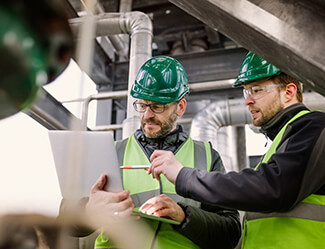Inspection Drones Take Safety to New Heights

Using a drone to perform worksite inspections is starting to become a popular alternative when workers need to gain access to some of the most dangerous sites or perform risky tasks. Examining the inside of a massive industrial boiler, the top of a 2,000-foot tower, or even canvassing a vast dirt crevice, drones are taking care of some of the most dangerous job activities. Besides offering quick, real-time views to help manage assets, keep projects on track, and streamline collaborations, drones offer a modern and uplifting option for worker safety.
No Toying Around
Drone use is an attractive work assessment alternative for employers because it saves time and energy of a worker having to climb great heights or venture into dark and cramped confined spaces. Drone also make these processes safer as the worker avoids injury that could come from common job hazards such as entrapment or falls. Fatalities from slips, trips, or falls have been on an upward trend since 2011, according to the Bureau of Labor and Statistics. In 2016, there were 849 such deaths of workers in industries such as tree trimming, roofing work and inspections, and construction. A tally from 2016 BLS data also shows 102 workers died in confined space incidents.
Aerial drone technology can step in to assist in facility management and can handle these sort of risky tasks easily ? with an average 20 minute flying time covering a lot of ground. According to Zacc Dukowits, the director of marketing at Drone Pilot Ground School, when using a drone for risk assessment, companies can get details they need for:
- Prework inspections: These help identify worksite problems and other areas where work might be required and help determine the tools that a worker might need to complete a task.
- Hazard assessment: Dangers can be revealed such as a biological or structural hazard that could affect a worker's performance and their safety.
 Drones are easy to fly and, besides providing fast, real-time views, they can take still pictures and videos of projects that can be reviewed later. Along with the safety boosting factor, the process is oftentimes more cost effective than using several work crews to survey, report, and enter data. Drones also can access difficult areas and awkward locations, such as under large bridges.
Drones are easy to fly and, besides providing fast, real-time views, they can take still pictures and videos of projects that can be reviewed later. Along with the safety boosting factor, the process is oftentimes more cost effective than using several work crews to survey, report, and enter data. Drones also can access difficult areas and awkward locations, such as under large bridges.
At Con Edison in New York, engineers use drones to look at large industrial burners for functionality. The drone flies through what is several stories of scaffolding for the average worker; eliminating hazards working from heights and confined spaces. In a video demonstration of drone usage at the facility, engineer Seth Flash says the drone inspections save costs at the facility and those cost savings then go on to customers.
"Our flight software allows you to set boundaries for a flight, capturing images within your area of interest," said Jevon Brun at Precision Hawk, a drone and data company in Raleigh, North Carolina. Like other commercial drones, Precision Hawk's can use ground control points to improve the accuracy of the maps it creates, Brun said. This imagery support system provides professionals, such as a land surveyor, for example, with an accurate view of a potential work site.
Set Sites on Safety
An ongoing site inspection is an important part of any safety program. While drones might be able to assist safety managers conduct site inspections and assess hazards, it may be easy to overlook something if the inspection is not thorough. Point out hazards on the job and prevent future incidents through a successful site inspection. Manage assets, keep projects on track, and streamline communication with workers. Use technology and modeling that includes necessary signs, labels, floor marking and other visual cues. Bring attention to high-voltage areas, shock hazards, restricted or limited clearance, or a variety of detailed warnings and instructions on safety precautions.
Related Resources

Improve Falling Objects, Struck-Bys in Construction
Falling objects and struck-bys are some of the most common job hazards that lead to injury or death in ...
Read
ANSI Issues Dropped Objects Standard
To help eliminate the hazards of dropped objects from heights, the International Safety Equipment Association ...
Read
Signs Your Excavation Site Needs Shoring Up
Excavations of all types require a variety of tools and techniques for safety and efficiency. A few things ...
Read.png)





